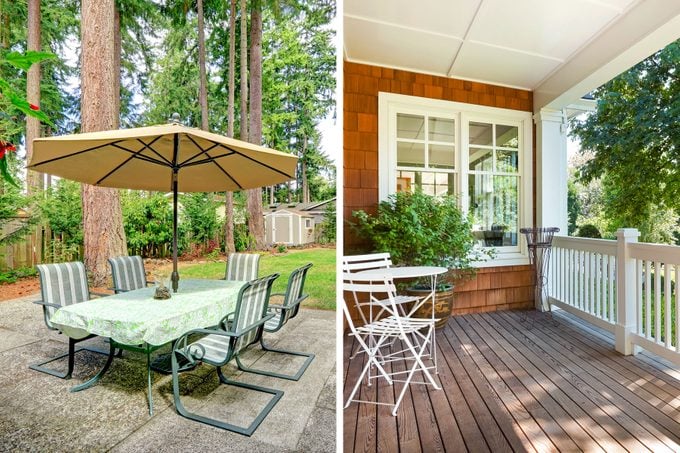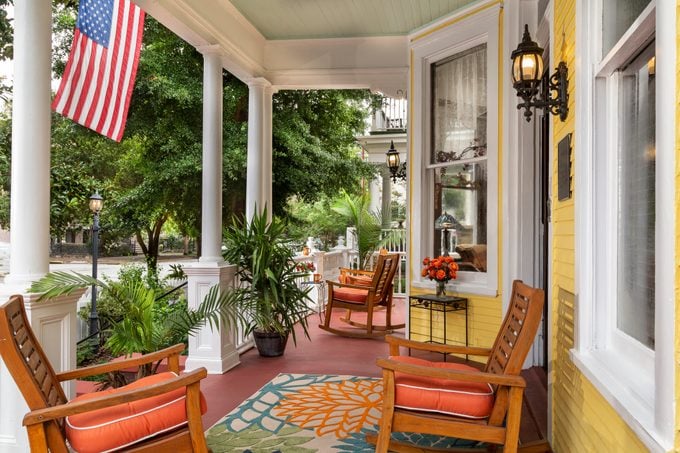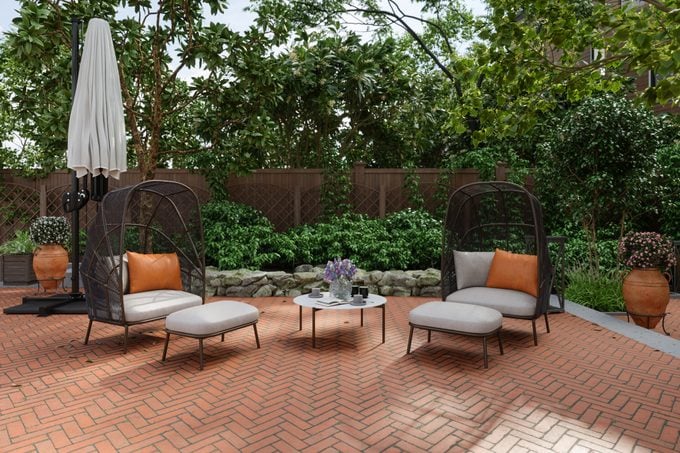Patio vs. Porch: What’s the Difference?
Updated: Apr. 24, 2024
The two words are often used interchangeably, but there are clear distinctions. Here's how what to know about a porch vs. a patio.

Most of my homes out west have included a large outdoor living space in the backyard perfect for barbecues, fire pits and social gatherings. But when I moved to Florida, where mosquitoes and rainstorms are prevalent, I soon came to appreciate the perks of fresh air combined with greater weather and pest protection.
If you’re trying to decide whether to build a porch vs. a patio, here’s how to figure out which is right for your home.
On This Page
What is a Porch?

By definition, porches are architectural structures connected directly to a home and accessible through a door. They are almost always covered by a roof and often located at the front of the house, with stairs leading down to ground level. Sometimes, they are also enclosed with screens or windows.
“Most have wood floors, though concrete floors are not unheard of,” says Rafi Friedman, the president of Coastal Luxury Outdoors. “These can be anything from a small shelter over your door all the way up to large outdoor living spaces that wrap around your home.”
How Much Does a Porch Cost to Build?
The cost of building a porch varies depending on the location, size, intricacy of features and how it attaches to your house. But nationwide, the average 200-square-foot porch runs around $14,500, according to Angi’s statistics.
“For a small porch under 100 square feet, without many features, it can cost about $4,500,” says Angie Hicks, cofounder of Angi. “For a larger 600-square-foot wraparound porch with features like lighting, heaters, fans and other elements it could cost up to $90,000.”
Porch Pros and Cons
Pros
“A porch is a great way to expand the space of your home,” says Hicks. “It can provide a relaxing, sheltered outdoor space that can be great for sitting out and enjoying a cup of coffee, even in the rain.”
Other benefits of porches include:
- Curb appeal
- Protecting outdoor furniture from the elements
- Psychological and health benefits from being outdoors
- Screens to protect from insects
“Porches are ideal for small, intimate gatherings and sitting quietly to watch the world go by,” says Friedman.
Cons
“Perhaps the most expensive part of building a porch is extending the roof out to cover it,” says Friedman. “This requires modifications to your home and specialized contractors to make sure the work is done correctly.”
Other cons of porches include:
- More expensive than patios
- More permit-intensive than patios
- Can be difficult to install
- Not safe for fire pits and fireplaces
- Cramped for larger gatherings and parties
“With a porch, it’s important to understand its limitations,” says Hicks. “Many people might add a porch thinking it can provide more entertaining space, but it is generally a smaller space that can’t accommodate larger groups, so is a bit more difficult for entertaining.”
What is a Patio?

Different from a porch, a patio is a freestanding structure built next to your home, such as a concrete pad. They are often located in the backyard and are simpler than porches, with minimal railing, covering and other structures.
“They can be made of pavers, flagstones or gravel, but concrete is by far the most common material choice,” says Friedman. “They’re large, open, flexible spaces that are good for everything from lounging, dining and grilling to quiet nights around the fire and a play space for kids.”
How Much Does a Patio Cost to Build?
Again, it varies according to size, materials, complexity, and whether you need to remove an existing patio or deck. However, the average price is around $4,000, according to Angi’s statistics.
“A good cost estimate for patios is around $15 to $25 per square foot, including labor and materials,” says Friedman. “So a 400-square-foot patio would cost around $8,000.”
Patio Pros and Cons
Pros
“Patios are a great way to entertain large groups of guests,” says Hicks. “They’re great places to set up tables and chairs, a movie projector or anything else you might dream up.”
Other benefits of patios include:
- Less maintenance than decks and porches
- More affordable
- Easier to install
- More open feeling
- More flexible use
Cons
- Don’t protect from weather
- Don’t protect from outdoor pests
- Accumulate dust and dirt faster
- Need more maintenance
“You’ll also need to do more accessorizing of your patio,” says Friedman. “Furniture, umbrellas, fire pits and grills can quickly add to the cost of your project.”
Porch vs. Patio: Which is Right for My Home?
Choosing between a porch vs. patio all comes down to what you want to do with the space. If you want a more intimate place to get fresh air that’s protected from bugs and weather, a porch is your go-to solution. But if want to entertain larger groups of people, or your budget is smaller, then a patio is the better option.
FAQ
What are the most common types of porches?
- Portico: a covered porch or walkway leading to an entrance of a building, often with support columns.
- Sunroom: a closed porch, usually enclosed by glass or plastic panels.
- Wraparound porch: a porch that wraps around multiple sides of a home, with doors accessing it from various rooms.
- Veranda: an open-air space protected by a roof and usually partly enclosed by a railing; common in the south, especially New Orleans.
- Back porch: an extension of the house into the backyard, sometimes connecting a kitchen to the backyard.
What are the most common types of patios?
“The thing that differentiates patios the most is the material used to build them,” says Hicks. The most common patio materials include:
- Concrete
- Brick pavers
- Gravel
- Natural stone or flagstone
- Permeable pavers
About the Experts
Angie Hicks is cofounder of Angi (formerly Angie’s List), where she also works as the Chief Customer Officer. Through her roles there, she’s helped guide people through home maintenance decisions for more than 25 years.
Rafi Friedman is president of Coastal Luxury Outdoors, in Jacksonville, Florida. He and his team have a collective 100 years of experience building backyard living spaces, including more than 100 pools annually.
